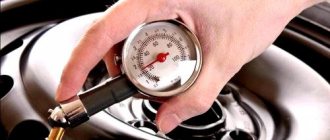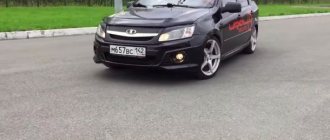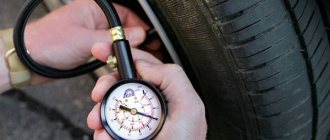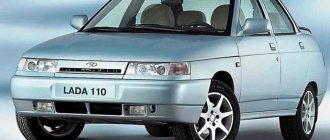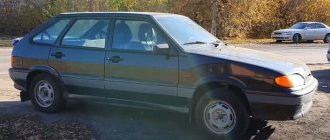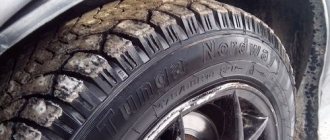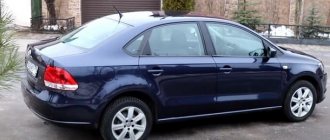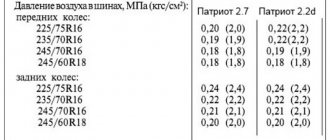The manufacturer sets the recommended tire pressure for Lada Kalina at 2.2 - 2.3 Atm. For front and rear axle. The manufacturer specifies reference values used under rated operating conditions. This:
- Outboard temperature within +20-25°C;
- Full load no more than 300 kg;
- Asphalt road surface of adequate quality.
In reality, indicators may differ significantly from those set by the factory. Users have calculated for themselves certain adjustments to the optimal pressure. In summer, during extreme heat, it is recommended to lower the tires by 0.2-0.3 bar. This is especially true when driving on the highway. Due to strong friction, the wheels heat up, which leads to the expansion of the air inside the cylinder.
In winter, the reverse process occurs. For every 10°C decrease in temperature, the pressure in the wheels drops by approximately 0.2-0.3 Atm, which indicates the need to inflate tires before leaving with a reserve.
Separately, you should consider the option of traveling on a bumpy road or dirt road. Here, hard tires can make the ride less comfortable. On the other hand, broken asphalt and under-inflated slopes cause cuts in the side of the slope. It is recommended to monitor the operating pressure whenever the road conditions change.
Separately, you should consider the difference in the tires themselves. Different models are distinguished by softness or hardness. On ROSSAVA and Continental tires with similar tread, the optimal pressure will differ slightly due to the difference in rubber composition.
Kalina Cross
Separately, we should highlight the model where wheels with standard size R15 are mounted. The factory recommends pumping low-profile tires a little harder. This is 2.4/2.5 ATM for the front and rear axles of the vehicle.
This is because the standard low-profile Pirelli tires need to be stiffer to improve traction and control of the car. The comfort of passengers and the driver is not taken into account here - the racing version is designed taking into account aggressive use.
What does it depend on
The main factor influencing the tire pressure of the Lada Kalina is temperature. The higher the temperature, the greater it is. The temperature depends on external weather conditions and driving style (with aggressive driving, the tires heat up faster, so the indicator increases even more). This is typical in summer when the air temperature is very high.
Normal tire pressure "Lada Kalina"
In winter, it’s the other way around – after pumping up the required pressure in a warm garage and going outside in sub-zero temperatures, drivers notice a drop in performance. The wheels need to be inflated again.
Temperature affects not only the pressure in tires, but also the structure of the tire itself, which changes when it gets colder. Because of this, the tire may leak at the contact point between the disc and the tire.
A more powerful car, the Lada Kalina Cross, requires its own tire pressure.
Tires R15
For modifications of cars with 15-radius wheels, the manufacturer provides a more stringent operating mode. The company’s form table indicates that the optimal pressure will be within 2.4/2.5 BAR, respectively, for the front and rear of the car.
It is strictly not recommended to reduce the level of pumping below normal. Actions may cause damage to the sidewall of the tire or its self-disassembly while driving.
What pressure are we pumping?
Winter 1.9 – Summer 2.1
- In winter 1.9 bar . We often drive through the private sector, where there is slush and dirt. Lower pressure makes it easier to drive through bad roads and more difficult to get stuck.
- In summer 2.1 bar . Personally, I like it better this way. The car is stiffer and more controllable. Everyone decides for themselves. It also depends on the tires. We have Yokogama C.Drive .
Maximum tire pressure parameters
Optimal pressure
- VAZ-1117 ( station wagon ). At partial load – 1.9 atm and no more than 2.1 atm at full load. Here you have already slightly exceeded the factory recommended parameters. If you drive with a completely full load, then pump 2.1 atm ; if you just load the trunk with “country trash,” then pump 2.0 atm.
- VAZ-1118 ( sedan ). Within 1.9 at partial load and up to 2.1 at full load.
- VAZ-1119 ( hatchback ). At full load - from 2.0 to 2.2 , and at partial load, 2.0 atm .
Pay attention to what tires you have. Each tire manufacturer independently determines the optimal level of wheel inflation. But there are also averages that motorists should adhere to.
On foreign cars the pressure indicators are indicated on the rack, but here it’s empty!
To ensure optimal tire inflation, you must use an electronic or mechanical pressure gauge.
Partial loading of a car is when there are no more than 3 people in the cabin and the trunk is empty. Full loading occurs with maximum seating and the presence of cargo in the trunk.
Lada Kalina tire pressure table
| Tire size | Front axle | Rear axle | ||
| Summer | Winter | Summer | Winter | |
| 175/70R13 | 2,2 | 2,4 | 2,3 | 2,5 |
| 175/65R14 | 2,2 | 2,4 | 2,3 | 2,5 |
| 185/55R15 | 2,4 | 2,6 | 2,5 | 2,6 |
The norm for each season is different.
Car modifications
Lada Kalina was produced for 14 years. The manufacturer offered the consumer two generations of small class cars.
First generation
The debut car of the Kalina family appeared at AvtoVAZ in 2004. It was released as a sedan. The first generation cars were equipped with 1.4 liter (89 hp) and 1.6 liter (81 and 98 hp) petrol engines. In 2006, Kalina hatchbacks appeared, the next year - station wagons, and a year later - a sports modification. Depending on the configuration, the car was equipped with ABS, electronic power steering, airbags, and an air conditioning system. During production, changes were constantly made to the equipment of the vehicle. In 2009 and 2011, Lada Kalina became one of the best-selling brands in the country.
Second generation
In 2013, the plant's conveyor belt was modernized to begin production of the next generation of cars. LADA Kalina 2 was produced in hatchback and station wagon bodies. It is characterized by a more modern appearance, better aerodynamics and increased comfort. Improved powertrain, suspension and gearbox are distinctive features of the vehicle compared to previous generation models. Both hatchbacks and station wagons were equipped with 1.6 liter engines with variable intake, the power of which varied between 87...106 hp. A manual or automatic transmission was installed.
The maximum configuration included the installation of anti-lock systems, stability control, air conditioning and navigation, a traction control module, an after-braking system, a passenger airbag, a touch screen, heated front seats, a rain sensor, etc.
The latest modification of the Kalina family is the Lada Kalina Cross. It is distinguished by increased ground clearance, a modified final drive ratio and a more aesthetic appearance, for example, due to decorative trims on the wheel arches and sills.
In 2022, production of Kalina family cars was discontinued.
What non-standard sizes can be supplied?
Many Lada Kalina car owners want to make the design of their cars more presentable by installing wheels of non-standard width and diameter. The manufacturer allows the installation of wheels with non-standard sizes on the car:
- 175/65 R14;
- 185/60 R14;
- 185/55 R15.
When choosing new wheels, it is important to keep the rim width in mind. It is advisable to purchase only tires recommended by AvtoVAZ. It is important to remember that tire size affects handling. For example, when increasing the bus:
- the car behaves more stable on the road;
- controllability improves;
- The car turns easier.
Simultaneously with the increase in wheel width, the tread begins to drain water from the contact patch worse. As a result, the car handles much worse and other problems arise. Comfort on uneven roads also deteriorates when using low-profile tires. Since low height leads to constant shock to the suspension.
Selection of tires and wheels for the car
On this page you can select tires and wheels for your vehicle. The table shows several acceptable tire and wheel sizes for each car model, but the diameter of the wheels and tires must be the same.
If you cannot find a given tire size on sale, you can select replacement tires through an online service - a tire calculator. The tire calculator database is systematically updated and everything is up to date. This tire calculator will help you not only choose the right tire size, but also compare fuel consumption between selected tire sizes. For safety reasons, we recommend using only those tire sizes that are approved by the manufacturer of your specific vehicle model.
Source
How to measure blood pressure correctly
There are only two methods here - either a car or a stationary pressure gauge is used to check (you can find it at a gas station or in a tire shop).
First of all, you need to make sure that the tire is “cold”, since you cannot reduce the pressure in “hot” tires. When the car moves, the rubber heats up, and, accordingly, the pressure increases - this also needs to be remembered.
What tire sizes does the manufacturer recommend to install?
The manufacturer recommends different tire sizes and wheel diameters - it is necessary to take into account the modification and filling of the car. The type of body on which the installation is carried out is also important.
For cars with the “standard” and “norm” configurations when using standard 5 1/2J wheels, the manufacturer recommends using the following tire models:
- 175/65R14 with a speed index of 82H;
- 185/60R14 with a speed index of 82H.
Regardless of the rim width used, the rim offset must be 35 mm. For luxury vehicles, the following types of tires are used:
- 175/65R14;
- 185/60R14;
- 185/55R15.
It should be noted that the rim width for the “luxury” configuration may differ. Modifications with 5 ½ J and 6J are presented. It is worth noting: the listed standards apply to modifications 2192, 2194 (hatchback, station wagon).
The body design and chassis of the Cross 2194 Lada Kalina are significantly different. The manufacturer installs 15-inch diameter tires on this model with a wheel width of 195 mm and a tread height of 55 mm. The speed index is 85H, the rim width is 6J. Rim offset, ET – 33 mm. The manufacturer installs only radial tires.
Owners should remember: cars of even the same year of manufacture can be equipped with tires of different brands from the factory.
The reason for this is the change in the cost of wheels throughout the year. The car plant purchases a large batch at once. After the stock runs out, the plant purchases new tires. Moreover, the dimension remains the same. However, the manufacturer may vary.
Also a separate category is the Kalina Sport modification. The factory installs wheels with the following overall dimensions on it:
- 15 inches diameter: 185/55 mm; 195/50 mm;
- 16 inches in diameter – 195/50 mm;
- diameter 17 inches - 205/40 mm.
Control standards
Don't forget to use the pressure gauge before starting your ride. Properly inflated tires are the key to your safety.
Always use a vehicle with a standard tire air density reading. With overinflated tires, not only does uneven tire wear occur, but also, as a rule, the braking distance increases. This will happen due to incomplete contact of the tire with the road. You also risk harming your tires, since overinflated wheels receive significant shock loads on uneven surfaces.
Tire pressure monitoring
With reduced tire pressure, driving a vehicle becomes more difficult. The danger of getting into a skid increases during sudden maneuvers. The vehicle consumes more fuel and, accordingly, uneven tire wear occurs.
The measurement is carried out with a special pressure gauge, which can be:
- Mechanical (switch);
- Electronic.
The unit of measurement is:
- Atmosphere (Bar) - in Russia and CIS countries;
- PSI (pounds per square inch) - in Europe, USA.
Important to remember! To measure pressure, look for a high-quality device; you should not buy cheap products or their analogues from China.
Check the pressure immediately before driving on cold tires.
Wheel rubber manufacturers
For the Priora, Granta (liftback) or other Lada model, you can find the following types of tires on the market:
- Matador 175/70 R13 Nordicca MP 52 82T. Used for driving in cold seasons. The product performed well on dry and wet surfaces, ice and snow. If you use the product for a Granta (sedan or liftback), inflate the wheels to 2 atm according to the manufacturer’s instructions;
- Bridgestone 175/70 R13 Blizzak Revo GZ 82s. Represents a group of studless winter wheels with a soft tread compound. Equipped with a large number of slats. For Priora, a pressure value from 2 to 2.5 atm is suitable, which is allowed by the characteristics of the product of this company;
Bridgestone Blizzak winter tires
- Kleber 175/70 R13 Viaxer 82T. The improved rubber composition is intended for travel in the warm season. It has precision control and is equipped with drainage channels. The optimal pumping value for such products is 2.2 atm;
- Nokian 175/70 R13 Hakkapeliitta R2 82R. It has a herringbone pattern and is also equipped with slats. It is characterized by soft rubber in the tread and does not accumulate snow in the contact patch with the road surface. Inflates from 2 atm, which is suitable for “Granta”;
Winter tires Nokian Hakkapeliitta
- Fulda 175/70 R13 Ecocontrol 82T. Designed for summer use, made in Poland. The manufacturer allows tire inflation up to 2.5 atm;
- Barum 175/70 R13 Brillantis 2 82T. Recommended for use on Grant, Priora and other varieties of Lada in terms of price and quality ratio.
Source
European Internal Market (EUDM)
Tires for LADA Kalina Cross 1.6i 2017
European internal market
The hole in the center of the disk is known as the center hole diameter
.
Measured in millimeters. Factory installed discs have a center hole diameter that matches the diameter of the hub boss. In this case, the load is distributed on the hub, and the disk itself is centered, which avoids vibration
at high speeds.
The wheels are attached to the car hubs with bolts or studs and nuts. In the second case, the studs are rigidly fixed in the hub. The clamping parts of the wheel fastening bolts and nuts can be conical or spherical and must necessarily coincide with the profile of the holes in the wheel disk, as they ensure correct alignment of the wheel on the hub.
Metric thread example: M12 x 1.25
Thread diameter (mm) x thread pitch (mm)
Inch thread example: 9/16″ - 18 UNF
Thread diameter (in inches) - thread pitch
UNF - unified inch thread with fine pitch
Rim width (in inches) x wheel rim diameter (in inches)
ET35 - disc offset (distance between the wheel disc mounting plane and the rim symmetry plane, mm), positive 35 mm.
This is the diameter of an imaginary circle drawn through the centers of the disk mounting holes.
PCD is measured in mm. For example, 4×100 means that the wheel has 4 mounting holes and the diameter of the imaginary circle through the centers of the mounting holes is 100 mm.
Recommended cold tire pressure, measured in bar or PSI.
Rim width (in inches) x wheel rim diameter (in inches)
ET35 - disc offset (distance between the wheel disc mounting plane and the rim symmetry plane, mm), positive 35 mm.
This is the diameter of an imaginary circle drawn through the centers of the disk mounting holes.
PCD is measured in mm. For example, 4×100 means that the wheel has 4 mounting holes and the diameter of the imaginary circle through the centers of the mounting holes is 100 mm.
Recommended cold tire pressure, measured in bar or PSI.
Rim width (in inches) x wheel rim diameter (in inches)
ET35 - disc offset (distance between the wheel disc mounting plane and the rim symmetry plane, mm), positive 35 mm.
This is the diameter of an imaginary circle drawn through the centers of the disk mounting holes.
When a decrease or excess of pressure is allowed
There are situations in which violating the manufacturer’s recommendations is only for the benefit of the car. We are now talking about the contact patch, which increases with decreasing pressure in the tread and vice versa (decreases with increasing). When might this come in handy?
When driving on soft ground
By reducing the pressure by about one-fourth, you will thereby increase the contact patch by almost one and a half times. Accordingly, the movement will be easier, since the pressure on the soil will decrease.
Thanks for subscribing!
When driving on wet asphalt
By increasing the pressure, you will reduce the contact patch, which will reduce the risk of so-called aquaplaning. However, it should be noted that this rule does not apply to more modern tires, since they are initially designed to drain water.
When moving on rocky ground
In this case, the pressure can be increased, which will reduce the likelihood of damage to the tire sidewall. Don’t forget to return your blood pressure to normal after you’ve completed a difficult section of the trail.
To improve handling
By increasing the pressure, you can improve the car's handling and also reduce fuel consumption. However, you should not get too carried away with this, otherwise, in addition to all the advantages, you can get one rather significant disadvantage - an increased risk of a tire explosion.
Remember that blood pressure tends to decrease gradually, day after day. In summer it decreases a little more, and in cold weather, on the contrary, more slowly. Another important nuance is that some car models have different pressure levels on different axles. Do not forget to control the pressure and pump up the tires if necessary, and then driving will be safe for both you and others.

